6 Benefits of Kettlebell Training (+ Exercises For Runners)
Kettlebell exercises are great for building whole body strength & stability. Learn all the benefits of kettlebell training & how they improve your running.
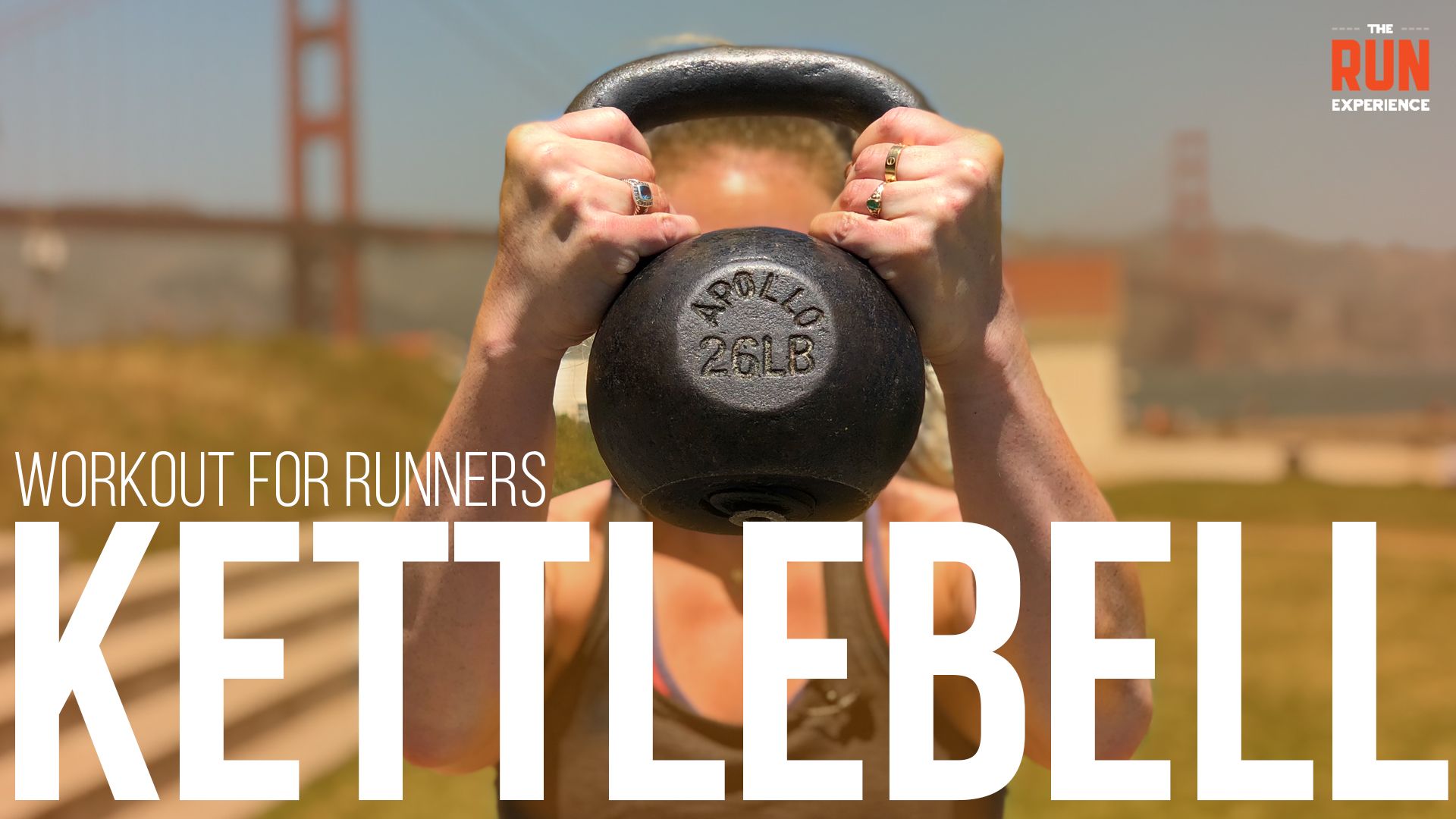
A kettlebell may just look like a cannonball with a handle on it. True. But this piece of equipment can be deceptively useful to all athletes, including runners. Kettlebell exercises can over offer surprising benefits, including:
- Building strength
- Encouraging core stability
- Improving running form
- Challenging your range of motion
And that’s not the end of kettle benefits—there are other advantages every runner can benefit from, from the first time 5k racer to an ultramarathoner. Below, we’ll talk about the top 6 benefits of kettlebell training, plus we’ll walk you through a few of our favorite kettlebell exercises.
Benefits of Kettlebell Training
1. Build strength and power
Just like when working with dumbbells or a barbell, a kettlebell can be used to build strength. Common bodyweight exercises like lunges, deadlifts, bent rows, and shoulder presses can all use a kettlebell to add weight to the movement, getting progressively heavier as you develop strength.
Building strength can only help your running, especially when you’ve been training for a while and need a new stimulus.
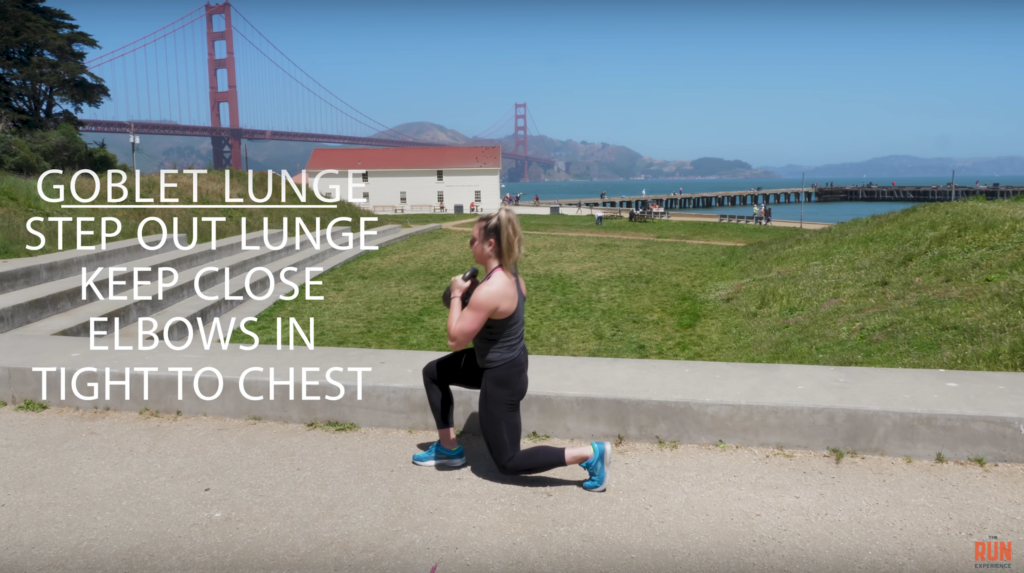
The glutes are the big powerhouse of running, and many of the most common kettlebell exercises either directly work the glutes, or at the very least require them to remain engaged throughout the movement.
For example, the kettlebell swing finishes each repetition with the weight extended in front of you. Your hips are pushed forward and your glutes are squeezed for that second before the weight falls back for the next set up.
A Romanian deadlift with the kettlebell not only challenges your balance but also recruits your glutes. First to pull you through the movement and then propel you back to a standing position. You should definitely feel them firing!
The key benefit of kettlebell training is that the dynamic nature of certain movements (like the swing) are great for developing power. When you have to suddenly jump up on a curb or over a rock, you use power to propel yourself. A swing requires you to propel the kettlebell’s weight upward (using those glutes!).
This translates to the same power needed for those occasional jumps on the run.
2. Core engagement and stability
Kettlebell exercises offer awesome opportunities to work on core engagement and stability. Whether it’s held in the middle of the body in what’s called a “goblet hold”, or on one side of the body in a “rack position,” having to hold the weight encourages engagement in your core. That way you aren’t tipping forward or leaning to one side.
Who doesn’t want that extra bit of core muscle work during their workout?
As runners, we spend a lot of time on one foot. In fact, running is a unilateral movement, meaning one side at a time. When fatigue sets in during a run, runners will sometimes start slumping or rotating from side to side. This can lead to a whole host of problems and injuries.
To develop the core stability all runners need, kettlebell exercises like the swing, lunge, single arm shoulder press, or goblet squat are all excellent options. Each exercise mentioned demands that you keep your core engaged and stable through the movement to maintain your balance and upright position. This benefit of kettlebell training can’t be understated—you have to have core strength and stability to maintain good running form.
Let your core relax while holding a kettlebell in the goblet hold, and you’ll quickly realize your mistake. Try the same check-in of turning your core “off and on” during a run, and you’ll see the similarity.
3. Posture
We need to be mindful of our posture not only when out on the road and trail, but also in our day-to-day activities. Whether working at a desk, carrying around a backpack, or training in the gym, your posture matters. Hunching over at work all day and then going to the gym to hunch over your phone between reps won’t help you at all.
Instead, take the time to focus on standing tall with your weight evenly distributed on both feet. This stance will be the same used for movements like a kettlebell squat or deadlift.
Working on your kettlebell training posture will directly correlate with your running and resting form. If you can nail these kettlebell exercises with proper form, you’ll have no problem engaging your core at the computer desk or picking up the grocery bags at the store.
4. Run form
Imagine yourself holding a kettlebell in both hands at chest height, right in front of your body. For example, at the top of the squat, we just mentioned. Or at the start of the overhead press. Are your shoulders slouched forward and your back rounded?
No way! If they were, you’d tip forward and fall on your face.
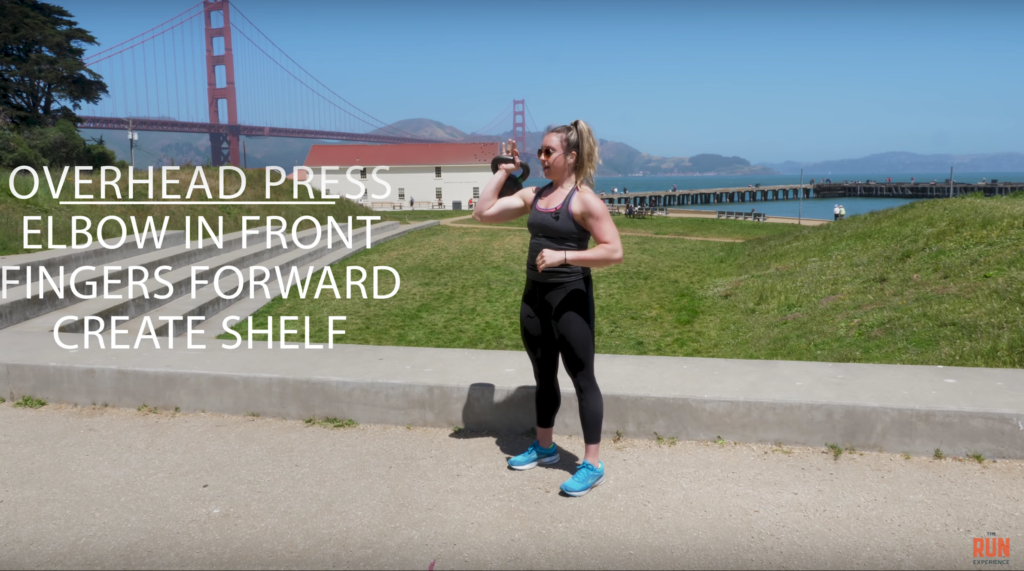
Your shoulder blades are engaged and pulled back and down. The lats are engaged to support the weight. These two cues – shoulders back and down, lats engaged – are the same ones you want to employ while running. By doing so, you’re encouraging a solid arm swing that moves straight forward and back. This prevents your torso from over-rotating and helps propel you forward.
When running, we repeat the same stride over and over for miles (or hours!) at a time. This can result in short, tight hip flexors. Over time, this can shorten your stride, reduce your power output, and lead to more of a shuffling movement than a strong stride.
To counteract this, using kettlebells in exercises to engage the glutes and extend the hip flexors can significantly improve your running form. Think of your hips in the finishing position of kettlebell deadlift. Your hips pushed forward, glutes squeezed.
This mental connection between kettlebell exercises and running form is one of the biggest benefits of kettlebell training—it might sound granola, but visualize the movements.
That hip forward position is the same one that should be seen at the end of every single running stride, right before your leg snaps back to take the next step.
5. Range of motion
Dynamic movements like the kettlebell swing can do wonders to challenge our range of motion under load. Rather than passively stretching the lats and shoulders, use the weight of the kettlebell at the top of the swing to create a little more range with each repetition.
As you bring the weight overhead at the top of the swing, you get another chance to engage your lats while also bringing your shoulders into rotation with your arms up by your ears. Talk about a lot going on!
If your shoulders or pecs are tight and don’t allow your arms to travel up as far as you’d expect, then you know you’ve got some work to do on your upper body mobility.
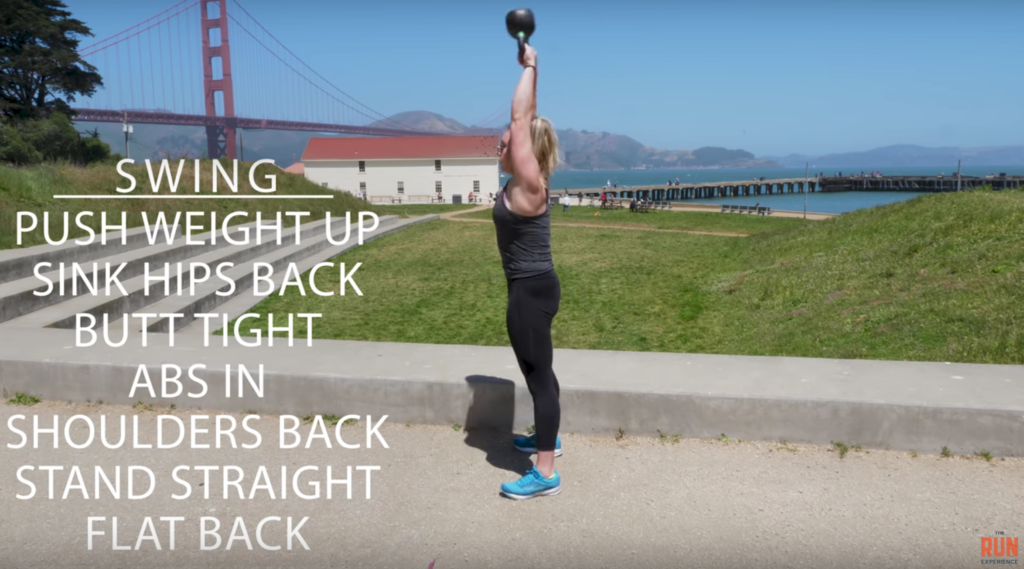
As mentioned in the previous section, your hips also get a great dose of extension in many of our favorite kettlebell movements like the lunge, swing, and deadlift. Every time you lunge forward, your rear leg gets to hit end range of motion. Moving through this position opens your hip up further.
Bonus – holding a kettlebell in the goblet hold (both hands in front of your chest) during the lunge will get your core firing to keep you upright and stable.
Each time you hinge forward in a kettlebell swing, your hamstrings get a stretch through their full range of motion as well. As you work through the repetitions of a workout featuring swings, don’t be surprised to feel yourself able to swing back just a bit farther as your hamstrings loosen up and create more space.
Just don’t forget to roll out those hamstrings at the end of your workout to avoid some major soreness!
6. Simplicity
Being able to use a single piece of equipment for a workout that will challenge your whole body is pretty handy. You can use the same kettlebell for a circuit of the swing, a lunge, a squat, and maybe even a push press.
Not a bad deal, right? Of course, you can change up the weights throughout the workout if you have multiple kettlebells available to you. If you don’t, a single one will do the trick!
Many of the most popular kettlebell exercises are also compound movements, meaning they work multiple muscles at once. For example, a kettlebell deadlift recruits your hamstrings, glutes, and lats throughout the movement. This way you can avoid doing separate, isolated exercises for each muscle group.
Not only does it save you time, but it also teaches your body to move functionally. Running isn’t done one muscle at a time. It’s a whole system of cooperating movements – so why not train that way?
The Best Kettlebell Exercises for Runners
Kettlebell exercises offer runners a compact, efficient way to cross-train, building strength, improving endurance, and enhancing running economy. Incorporating kettlebell workouts into your training can help prevent injuries by strengthening the muscles and joints used in running.
Here are some of the best kettlebell exercises tailored specifically for runners, aimed at enhancing performance and reducing the risk of common running injuries.
1. Kettlebell Swings
Targets: Glutes, hamstrings, core, lower back, and shoulders.
Why It's Great for Runners: Kettlebell swings develop explosive power in the posterior chain, crucial for improving sprinting speed and running efficiency. The dynamic nature of the swing also helps improve hip mobility and endurance.
2. Goblet Squats
Targets: Quads, glutes, calves, and core.
Why It's Great for Runners: This squat variation increases lower body strength and flexibility, particularly in the hips and calves, which is essential for maintaining proper running form and preventing injuries.
3. Turkish Get-Ups
Targets: Shoulders, core, hips, and stabilizing muscles.
Why It's Great for Runners: The Turkish Get-Up is a total-body exercise that improves mobility, stability, and functional strength. It's particularly beneficial for building a strong core and improving balance, both vital for efficient running.
4. Single-Arm Kettlebell Press
Targets: Shoulders, upper back, and core.
Why It's Great for Runners: Strengthening the shoulders and upper back can improve running posture and arm swing, which in turn enhances running efficiency. The single-arm press also challenges the core, promoting stability.
5. Kettlebell Lunge Pass Through
Targets: Quads, hamstrings, glutes, and core.
Why It's Great for Runners: Lunges mimic the running motion, making them an excellent exercise for building leg strength and improving balance. The pass-through element adds a dynamic core stability challenge, enhancing coordination and agility.
6. Kettlebell Deadlift
Targets: Hamstrings, glutes, lower back, and core.
Why It's Great for Runners: Deadlifts focus on the posterior chain strength, crucial for propelling the body forward during running. Strengthening these areas can help increase stride length and speed while reducing the risk of injury.
7. Russian Twists with Kettlebell
Targets: Obliques, abs, and lower back.
Why It's Great for Runners: A strong core is essential for maintaining stability, especially during long runs or when fatigue sets in. Russian Twists strengthen the oblique muscles, aiding in better posture and more efficient energy transfer across the body.
8. Kettlebell Renegade Rows
Targets: Core, back, shoulders, and arms.
Why It's Great for Runners: This challenging exercise strengthens the core and upper body, improving posture and arm drive during running. The dynamic rowing motion also enhances shoulder stability and coordination.
Kettlebell Running Workout
Combining kettlebell exercises with running can create a dynamic, full-body workout that enhances strength, endurance, and cardiovascular health. This type of workout merges the explosive strength training benefits of kettlebells with the aerobic benefits of running, offering a balanced approach to fitness. Here's a comprehensive kettlebell running workout you can try:
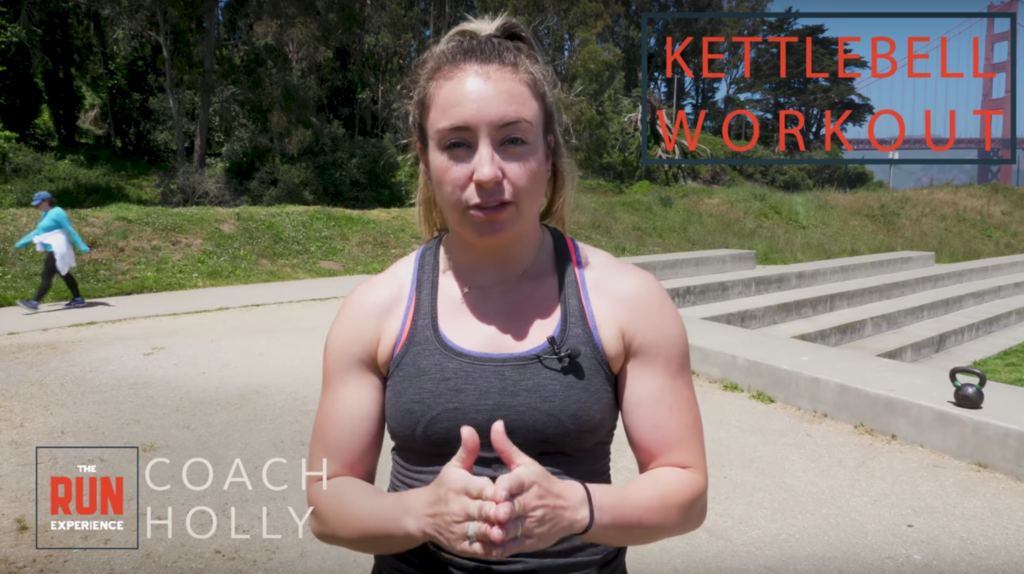
Warm-Up (5-10 minutes)
Start with a dynamic warm-up to prepare your body for exercise. Include movements such as leg swings, arm circles, hip circles, and light jogging to gradually increase your heart rate.
Kettlebell Circuit (Perform each exercise for 45 seconds with a 15-second rest between exercises)
- Kettlebell Swings: Focus on using your hips to drive the movement, keeping your core engaged and your back straight.
- Goblet Squats: Hold the kettlebell close to your chest. Squat down, keeping your knees in line with your toes, and drive back up through your heels.
- Kettlebell Deadlifts: With the kettlebell on the ground between your feet, hinge at your hips to lower down and pick it up, keeping your back flat.
- Kettlebell Rows: Bend slightly at the knees and hinge at the waist. Row the kettlebell to your side, keeping your elbow close to your body.
- Russian Twists: Sit on the ground with your knees bent, lean back slightly, and twist from side to side, moving the kettlebell across your body.
Running Interval (10-20 minutes)
After completing the kettlebell circuit, transition to a running interval. Choose between steady-state running or interval training based on your fitness level and goals. For interval training, alternate between sprinting for 30 seconds and jogging or walking for 1 minute.
Repeat Kettlebell Circuit
Return to the kettlebell circuit and go through each exercise again for another round. Adjust the duration based on your fitness level, aiming for 2-3 total rounds.
Running Interval (10-20 minutes)
Repeat the running interval session, following the same format as before. You can adjust the intensity and duration to match your fitness level and how you're feeling on the day.
Cool Down and Stretch (5-10 minutes)
Finish your workout with a cool-down period consisting of light jogging or walking, gradually decreasing in intensity. Follow up with static stretching, focusing on major muscle groups used during the workout, such as hamstrings, quads, calves, back, and shoulders.
Tips for Success
- Choose the Right Kettlebell Weight: Start with a weight that is challenging but allows you to complete each exercise with proper form. As you become stronger, you can increase the weight.
- Focus on Form: Prioritize maintaining correct form throughout the workout to maximize benefits and reduce the risk of injury.
- Hydrate and Refuel: Drink plenty of water before, during, and after your workout. Consider a balanced snack or meal post-workout to help with recovery.
- Listen to Your Body: Adjust the intensity and volume of the workout according to how you're feeling. It's important to push yourself but also to recognize when you need to take it easy.
This kettlebell running workout offers a balanced approach to improving your strength, endurance, and overall fitness. By combining strength training with aerobic exercise, you'll be working towards a well-rounded fitness regimen that promotes health and performance.
Start Your Kettlebell Training
Now that you’ve seen the benefits of kettlebell training in action, it’s time to go see for yourself. Incorporate these kettlebell exercises into your training routine and see how it impacts your running for the better.
We’ve got plenty more training tips and programs for you! From injury prevention to full race distance plans, check out the running training program, our subscription service to a full library of tools and plans to help you become the runner you want to be.
